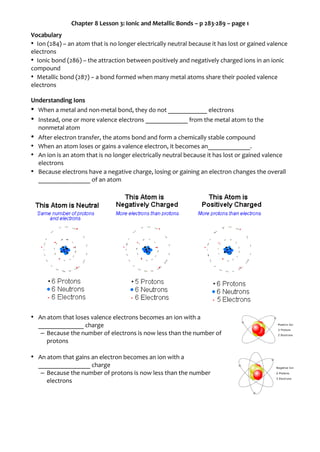
Chapter 8.3: Ionic and Metallic Bonds
- 1. Chapter 8 Lesson 3: Ionic and Metallic Bonds – p 283-289 – page 1 Vocabulary • Ion (284) – an atom that is no longer electrically neutral because it has lost or gained valence electrons • Ionic bond (286) – the attraction between positively and negatively charged ions in an ionic compound • Metallic bond (287) – a bond formed when many metal atoms share their pooled valence electrons Understanding Ions • • When a metal and non-metal bond, they do not ____________ electrons Instead, one or more valence electrons _____________ from the metal atom to the nonmetal atom • After electron transfer, the atoms bond and form a chemically stable compound • When an atom loses or gains a valence electron, it becomes an_____________. • An ion is an atom that is no longer electrically neutral because it has lost or gained valence electrons • Because electrons have a negative charge, losing or gaining an electron changes the overall ________________ of an atom • An atom that loses valence electrons becomes an ion with a ______________ charge – Because the number of electrons is now less than the number of protons • An atom that gains an electron becomes an ion with a ________________ charge – Because the number of protons is now less than the number electrons
- 2. Chapter 8 Lesson 3: Ionic and Metallic Bonds – p 283-289 – page 2 Losing Valence Electrons • Look at Sodium – Sodium is a metal – It has an atomic number of _______ • That means 11 protons and 11 electrons – It is in group 1 • That means it has ____ valence electron – Therefore, it is _______________ • Metal atoms, such as sodium, become more stable when they lose valence electrons and form a chemical bond with a nonmetal • If sodium loses one electron it will have a total of __________ electrons, __________ of them being valence electrons – That means it would have the electron configuration of a noble gas. – It would be chemically ____________________. Gaining Valence Electrons • • Nonmetal atoms can also _________ valence electrons with metal atoms • • If a chlorine atom can gain one electron, it will have ______ valence electrons Look at chlorine – Chlorine has an atomic number of ___________ • That means 17 protons and 17 electrons – Its in group 17 • That means __________ valence electrons – It is chemically unstable Then, it will have the electron configuration of the noble gas ____________ (Ar).
- 3. Chapter 8 Lesson 3: Ionic and Metallic Bonds – p 283-289 – page 3 • When sodium loses a valence electron, it becomes a _______________ charged ion. – This is shown by a plus sign (+) • When a chlorine atom gains a valence electron, it becomes a ______________ charged ion. – This is shown by a negative sign (-) Determining an Ion’s Charge • Once an atom gains or loses electrons, it becomes a charged ion. • For example: – Nitrogen has 7 electrons and 7 protons – However, if N gains 3 electrons when forming an ion, the N ion then has 10 electrons • To determine the charge, _______________the number of electrons in the ion from the number of protons. 7 protons – 10 electrons = -3 charge – So, it is a N ion with a -3 charge, shown as N^3Ionic Bonds – Electron Transferring • Metal atoms typically lose valence electrons and __________________ atom typically gain valence electrons • In an ionic bond, the nonmetal atom _____________ the electrons that the metal atom loses • In NaCl – Na loses ___________ valence electron • Na becomes a positively charged ion – Cl gains that _________ electron • Cl becomes a negatively charged ion – These ions attract each other and form a stable ionic compound. • The _________________________between positively and negatively charged ions in an ionic compound is an ionic bond. Ionic Compounds • • Usually solid and __________ at room temperature Relatively ___________ melting and boiling points
- 4. Chapter 8 Lesson 3: Ionic and Metallic Bonds – p 283-289 – page 4 • • Many ionic compounds ___________ in water Water that contains ionic compounds is a good conductor of electricity. – This is because the electrical charge can pass from ion to ion in the solution Comparing Ionic and Covalent Compounds • When nonmetal ions bond to metal ions in an ionic compound, there are no molecules. • • Instead, there is a large collection of ______________charge ions. All of the ions attract each other and are held together by ionic bonds Metallic Bonds – Electron Pooling • Metal atoms form compounds with one another by_______________ , or pooling, their valence electrons • A ________________ bond is a bond formed when many metal atoms share their pooled valence electrons • • • • In metallic bonds, metal ions lose their valence electrons and become positive ions. The electrons move from ion to ion. Valence electrons in metals are not bonded to one atom. Instead, a “______________________________________” surrounds the positive ion Properties of Metallic Compounds • Metals are good conductors of _____________________ energy and electricity • Because the valence electrons can _______________ from ion to ion, they can easily conduct electric current. • Metal ions can slide past one another in the electron sea and move into new positions. • Metals are __________________because the valence electrons at the surface of the metal interact with light
- 5. Chapter 8 Lesson 3: Ionic and Metallic Bonds – p 283-289 – page 5
- 6. Chapter 8 Lesson 3: Ionic and Metallic Bonds – p 283-289 – page 6
